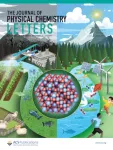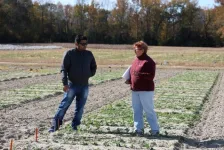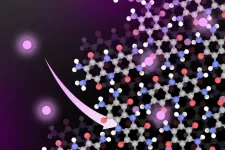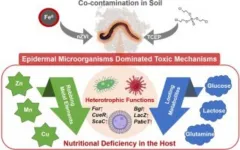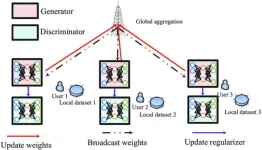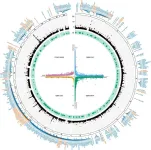Using magnetized neurons to treat Parkinson’s disease symptoms
2024-01-18
(Press-News.org) Electrical deep brain stimulation (DBS) is a well-established method for treating disordered movement in Parkinson’s disease. However, implanting electrodes in a person’s brain is an invasive and imprecise way to stimulate nerve cells. Researchers report in ACS’ Nano Letters a new application for the technique, called magnetogenetics, that uses very small magnets to wirelessly trigger specific, gene-edited nerve cells in the brain. The treatment effectively relieved motor symptoms in mice without damaging surrounding brain tissue.
In traditional DBS, a battery pack externally sends electrical signals through wires, activating nerve cells in a region of the brain called the subthalamic nucleus (STN). STN activation can relieve motor symptoms of Parkinson’s disease, including tremors, slowness, rigidity and involuntary movements. However, because the potential side effects, including brain hemorrhage and tissue damage, can be severe, DBS is usually reserved for people who have late-stage Parkinson’s disease or when symptoms are no longer manageable with medication. In a step toward a less invasive treatment, Minsuk Kwak and Jinwoo Cheon worked with their colleagues to develop a wireless method to effectively reduce motor dysfunction in people with Parkinson’s disease.
For their wireless technique, the researchers tagged nanoscale magnets with antibodies to help the molecules “stick” to the surface of STN nerve cells. Then they injected the sticky magnets into the brains of mice with early- and late-stage Parkinson’s disease. Prior to the injection in the STN, those same nerve cells had been modified with a gene that caused them to activate when the modified magnets on the cell’s surface twisted in reaction to an externally applied magnetic field of about 25 milliteslas, which is about one- thousandth the strength of an MRI.
In demonstrations of the magnetized and modified neurons in mice with Parkinson’s disease, the mice exposed to a magnetic field showed improved motor function to levels comparable to those of healthy mice. The team observed that mice that received multiple exposures to the magnetic field retained more than one-third of their motor improvements while mice that received one exposure retained almost no improvements. Additionally, the nerve cells of treated mice showed no significant damage in and around the STN, which suggests this could be a safer alternative to traditional implanted DBS systems, the researchers say. The team believes its wireless magnetogenetic approach has therapeutic potential and could be used to treat motor dysfunction in people with early- or late-stage Parkinson’s disease as well as other neurological disorders, such as epilepsy and Alzheimer’s disease.
The authors acknowledge funding from the Institute for Basic Science.
###
The American Chemical Society (ACS) is a nonprofit organization chartered by the U.S. Congress. ACS’ mission is to advance the broader chemistry enterprise and its practitioners for the benefit of Earth and all its people. The Society is a global leader in promoting excellence in science education and providing access to chemistry-related information and research through its multiple research solutions, peer-reviewed journals, scientific conferences, eBooks and weekly news periodical Chemical & Engineering News. ACS journals are among the most cited, most trusted and most read within the scientific literature; however, ACS itself does not conduct chemical research. As a leader in scientific information solutions, its CAS division partners with global innovators to accelerate breakthroughs by curating, connecting and analyzing the world’s scientific knowledge. ACS’ main offices are in Washington, D.C., and Columbus, Ohio.
To automatically receive news releases from the American Chemical Society, contact newsroom@acs.org.
Note: ACS does not conduct research, but publishes and publicizes peer-reviewed scientific studies.
Follow us: Twitter | Facebook | LinkedIn | Instagram
END
ELSE PRESS RELEASES FROM THIS DATE:
2024-01-18
Evolutionary biologists have long suspected that the diversification of a single species into multiple descendent species – that is, an “adaptive radiation” – is the result of each species adapting to a different environment. Yet formal tests of this hypothesis have been elusive owing to the difficulty of firmly establishing the relationship between species traits and evolutionary “fitness” for a group of related species that recently diverged from a common ancestral species.
A global team of biologists led by McGill University have compiled nearly two decades of field data – representing the study ...
2024-01-18
(MEMPHIS, Tenn., January 18, 2024) St. Jude Children’s Research Hospital today announced a nearly $13 million investment toward a new research collaboration with scientists at Columbia University, Duke University and Stanford University to expand the understanding of G-protein coupled receptors (GPCR), which are vital proteins that impact human health and disease.
The collaborative research project is led by two St. Jude researchers, Scott Blanchard, Ph.D., and M. Madan Babu, Ph.D., who are working with Nobel laureate and Howard Hughes Medical Institute investigator Robert Lefkowitz, M.D., of Duke University; Jonathan Javitch, M.D., Ph.D., of ...
2024-01-18
WPI Researchers have developed a material to remove urea from water and potentially convert it into hydrogen gas. By building these materials of nickel and cobalt atoms with carefully tailored electronic structures, the group has unlocked the potential to enable these transition metal oxides and hydroxides to selectively oxidize urea in an electrochemical reaction.
The study, led by Xiaowei Teng, the James H. Manning professor of Chemical Engineering at WPI, was recently published in the Journal of Physical Chemistry Letters and highlighted in the publication’s supplementary front cover.
The ...
2024-01-18
Consider the faba bean, also known as the fava bean or broad bean.
The bright-green legume has been enjoyed as a diet staple for thousands of years in Africa, Asia, and the Mediterranean. Just one cup of faba beans has 13 grams of protein — making it a better protein source than most other legumes — along with plenty of fiber, potassium, and iron. Plus, it’s a good cover crop that helps improve soil health, slow erosion, and control pests, disease, and weeds.
But you don’t often see it in the fields or on the menus in Virginia.
That’s why College of Agriculture and Life ...
2024-01-18
CAMBRIDGE, MA – Many electric vehicles are powered by batteries that contain cobalt — a metal that carries high financial, environmental, and social costs.
MIT researchers have now designed a battery material that could offer a more sustainable way to power electric cars. The new lithium-ion battery includes a cathode based on organic materials, instead of cobalt or nickel (another metal often used in lithium-ion batteries).
In a new study, the researchers showed that this material, which could be produced at much lower cost than cobalt-containing batteries, can conduct electricity at similar rates as cobalt batteries. The new battery also has comparable storage ...
2024-01-18
Epidermal microorganisms, vital in nutrient exchange between hosts and environments, have now been shown to play a key role in host toxicity through community changes. This research highlights how changes in the community of skin-based microbes correlate more significantly with earthworm toxicity than those in intestinal microorganisms, especially under combined soil contaminations.
A new study (https://doi.org/10.1016/j.eehl.2023.11.001) published in the journal Eco-Environment & Health, researchers from Zhejiang University revealed the crucial role of epidermal microorganisms in influencing earthworm toxicity under environmental stress, notably in conditions ...
2024-01-18
The collaboration between scientists, farmers and managers is crucial to improve the protection of the little bustard, an endangered steppe-land bird in Spain due to human activity. The reduction of natural habitats, the increase in irrigation and the urbanization of the land have led to having less surface areas that guarantee the survival of this vulnerable species. An article published in the journal Biological Conservation reveals how cooperation between different actors is key to finding answers and avoiding the decline of the most threatened populations of the little bustard.
The study, a pioneer example of adaptative conservation, ...
2024-01-18
In today's increasingly interconnected world, high-quality communication has become more vital than ever. Accurately estimating the dynamic status of communication channels is a key factor in achieving this. Recently, a joint research team designed a new algorithm that offers high-level estimation accuracy and privacy protection with low computational and communication costs. This research was published Jan. 5 in Intelligent Computing, a Science Partner Journal.
This new algorithm uses a specially designed deep learning model for precise estimation and a federated learning framework ...
2024-01-18
Glaucoma is the leading cause of irreversible blindness around the globe, affecting up to 44 million people. Although people of African ancestry are most frequently and severely affected by this hereditary disease, its genetic underpinnings in this population have rarely been studied. Now, a team of investigators has published findings revealing previously unknown inherited genetic variants that contribute to primary open-angle glaucoma (POAG), the most common form of the disease. The study was based on the analysis of 11,275 individuals of African descent and is being published January 18, 2024, in Cell.
“Individuals with African ancestry are five times more likely to be affected ...
2024-01-18
Damage caused by sea level rises could cost the EU and UK economies up to 872 billion Euros in total by the end of the century, according to a modelling study published in Scientific Reports.
Ignasi Cortés Arbués, Theodoros Chatzivasileiadis, Tatiana Filatova and colleagues modelled the potential economic impacts of sea level rises for 271 European regions by 2100 under a high emissions scenario (SSP5-RCP8.5) with no new coastal protection measures implemented after 2015. They combined ...
LAST 30 PRESS RELEASES:
[Press-News.org] Using magnetized neurons to treat Parkinson’s disease symptoms

